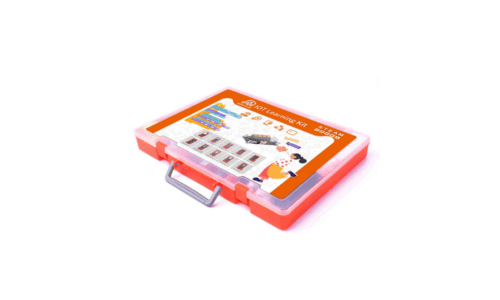Course Overview – IoT Learning Kit
The IoT Learning Kit is a complete educational solution to introduce students to the fascinating world of the Internet of Things (IoT). This hands-on course bridges the gap between the physical and digital worlds, enabling students to build smart, connected systems that sense, control, and communicate.
Through a progressive series of projects, learners explore the basics of embedded electronics, wireless communication, remote control, and mobile app development — all while solving real-world problems using sensors, actuators, and cloud platforms.
What Students Will Learn:
-
The fundamentals of IoT systems and architecture
-
How to use sensors (light, sound, temperature, gas, etc.)
-
How to collect and send data wirelessly
-
Control devices remotely through Bluetooth and Wi-Fi
-
Build custom mobile apps using App Inventor
-
Design and implement cloud-connected smart projects
Key Skills Developed:
-
Embedded programming and wireless protocols
-
Real-time data monitoring and control
-
App development and UI logic with App Inventor
-
System thinking and IoT architecture design
-
Smart automation and energy-efficient thinking
This course is ideal for:
-
Middle to high school students
-
STEM labs and IoT discovery programs
-
Future engineers and smart device enthusiasts
Connect the future — one sensor at a time.
Curriculum
- 5 Sections
- 14 Lessons
- 12 Weeks
- 🔹 Section 1: Introduction to the Internet of ThingsLearning Objective: Understand the basic concepts of IoT and how everyday objects can become smart and connected. Students will explore what IoT means and prepare for hands-on projects.1
- 🔹 Section 2: Local IoT ProjectsLearning Objective: Build smart devices that work locally using sensors and actuators. Projects like the alarm clock, weather station, or smart gate teach students how to automate tasks without needing internet connectivity.6
- 🔹 Section 3: Networked Communication & ControlLearning Objective: Learn how IoT devices communicate through Wi-Fi and cloud systems. Students build gateways and connected systems to exchange data in real time.4
- 🔹 Section 4: Mobile App DevelopmentLearning Objective: Use App Inventor to create simple mobile apps that control smart devices. This section introduces students to mobile interfaces and remote control.4
- 🔹 Section 5: Advanced and Real-World ApplicationsLearning Objective: Apply all acquired skills in complex, real-world scenarios like smart farming or comprehensive home automation. This final stage encourages creativity, integration, and project thinking.3
Instructor

